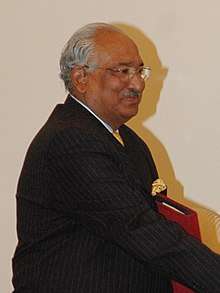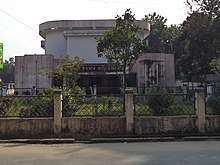Saifur Rahman (Bangladeshi politician)
Mohammad Saifur Rahman (Bengali: মোহাম্মদ সাইফুর রহমান) (October 6, 1932 – September 5, 2009) was a Bangladeshi economist and politician. He was a leader of the Bangladesh Nationalist Party and the longest-serving Finance Minister of Bangladesh. He delivered 12 national budgets in three terms between 1980–81, 1991–1996 and 2001–2006 over a ministerial life spanning from December 1976 until October 2006 in three different governments. He was Trade & Commerce Minister for the first three years, and thereafter Finance and Planning Minister for 12 years.[1]
Saifur Rahman | |
|---|---|
সাইফুর রহমান | |
 Rahman in March 2006 | |
| Minister of Finance | |
| In office 10 October 2001 – 28 October 2006 | |
| Prime Minister | Khaleda Zia |
| Preceded by | Shah A M S Kibria |
| Succeeded by | Abul Maal Abdul Muhith |
| In office March 1991 – March 1996 | |
| Preceded by | Mohammad Abdul Munim |
| Succeeded by | Shah A M S Kibria |
| In office April 1980 – May 1981 | |
| Succeeded by | Abul Maal Abdul Muhith |
| Member of Parliament for Maulvibazar-3 | |
| In office 15 February 1996 – 9 October 2001 | |
| Preceded by | Azizur Rahman |
| Succeeded by | M. Naser Rahman |
| Member of Parliament for Sylhet-1 | |
| In office 10 October 2001 – 28 October 2006 | |
| Preceded by | Humayun Rashid Chowdhury |
| Succeeded by | Abul Maal Abdul Muhith |
| Personal details | |
| Born | October 6, 1932 Baharmardan, Maulvi Bazar, Sylhet, British India (now Bangladesh) |
| Died | September 5, 2009 (aged 76) Ashuganj, Brahmanbaria, Bangladesh |
| Political party | Bangladesh Nationalist Party |
| Children | M. Naser Rahman |
| Parents | Abdul Basit and Talebunnessa |
| Alma mater | Dhaka University Institute of Chartered Accountants in England and Wales |
| Occupation | Chartered accountant |
In 1994, he was elected governor of the golden jubilee conference of the World Bank and International Monetary Fund in Madrid, Spain.[1] In 2005, Rahman was awarded Ekushey Padak, the highest state honor of Bangladesh.[1][2]
Life and career
Rahman was born on October 6, 1932, in the village of Baharmardan located in Mostafapur Union, Maulvibazar Sadar, Maulvi Bazar District, in the Sylhet Division of Bangladesh. His father was Abdul Basit.[3] As a young man, he participated in the Bengali Language Movement of 1952, part of a growing nationalism. He was vice-president of Salimullah Muslim Hall while at Dhaka University.[1]
In 2005, he was awarded Ekushey Padak, the second-highest state award, for his role in the Bengali Language Movement. A prominent chartered accountant, Rahman was one of the founders of Rahman Rahamn Huq (currently KPMG Bangladesh), a noted chartered accountancy firm.[1]
He founded three educational institutions: Sylhet Agricultural University, Sylhet Teacher's Training College, and Sylhet Engineering College.[1] Active in professional organizations, he was a founding member of the Bangladesh Institute of Law and International Affairs,[4] and served as the president of the Institute of Chartered Accountants of Bangladesh, and president of the United Nations Association of Bangladesh.
Education
Rahman graduated from Moulvibazar Government High School in 1949 and did his Intermediate from Sylhet MC College in 1951.[5] He graduated from Dhaka University with a B.Com (Hons) in 1953. The next year he went to London and studied to qualify as a Chartered Accountant; he earned his certificate from the Institute of Chartered Accountants in England & Wales. He became a specialist in monetary, fiscal and development economics.[6]
Politics
Rahman joined a political coalition called the Jatiyatabadi Ganatantrik Dal in 1977, who were supporters of then-president Ziaur Rahman. The party was formalized in 1978 as the Bangladesh Nationalist Party (BNP).[1] The party came into power after a general election in 1979, in which Rahman won a seat in parliament.
Rahman was appointed as the finance minister of the first BNP government under Ziaur Rahman, which he served until 1980.[7] Saifur Rahman prepared a record 12 budgets in Bangladesh; he has been praised for opening up Bangladesh's economy in the early 1990s and pioneering major economic reforms. He contributed to the expansion of the economy after the restoration of parliamentary democracy.[8] He served as a minister of Bangladesh for a total of 14 years.
Together with the BNP, Rahman was successful in the general elections of 2001. Contesting on behalf of his party in the parliamentary constituency Maulvibazar-3, Saifur Rahman gained 52 per cent of the total votes.[9] In another contest at the constituency Sylhet-1, Saifur Rahman secured 53 per cent of the total votes, again defeating a rival candidate from the Awami League.[10] As per the constitution, Saifur had to leave blank one of his won constituencies to proceed the house session. He decided to leave the Maulvibazar-3 seat which was later retaken by his son M. Naser Rahman,also representing Bangladesh Nationalist Party.[8]
In the general elections in 2008, Rahman was defeated in his two constituencies by the Awami League candidates. Abul Maal Abdul Muhith won in Sylhet-1, and was appointed as Finance Minister.
Personal life
Rahman married Duree Samad Rahman. They had three sons and a daughter together. Duree died of cancer in 2003. His son M. Naser Rahman has followed him into politics; in 2001 by-elections, he won his father's left constituency of Maulvibazar-3.
Death and legacy

Rahman died in a road crash on September 5, 2009, in Brahmanbaria District on his way to Dhaka from his home district of Maulvibazar. Taken unconscious from the car, he was declared dead after being rushed to a hospital.[11] On Friday he was in Sylhet visiting the shrines of Shah Jalal and Shah Paran, then headed for Moulvibazar. A total of five janazah prayers were held for Rahman, the first of which took place in Gulshan Azad Mosque, then at the BNP offices, Parliament buildings, Shahi Eidgah Maidan and Moulvibazar Government High School.[12] The BNP began three days of mourning for the passing.[13] Rahman was buried at his family graveyard beside his wife's grave in Baharmardan village after the prayers.[14][15]
Saifur Rahman is credited with being the architect of Bangladesh's economic transformation and liberalization in 1990s by introducing VAT, tax reforms and free market policies.[16] A M A Muhith, the Finance Minister, characterized Rahman's death as "a loss to the nation."[2] The United States mentioned his "critical role in improving the lives and bringing prosperity to millions of Bangladeshis by opening Bangladesh's economy and promoting free market reforms."[2]
Awards
- Ekushey Padak, 2005 for role in Bengali Language Movement[1][2]
- Order Nationale, Highest National Order of Senegal[17]
References
- "Saifur Rahman's life sketch". The Daily Star. 5 September 2009. Archived from the original on 2012-10-07.
- "Ex-finance minister Saifur Rahman dead". The Financial Express. 6 September 2009. Archived from the original on 2009-09-09.
- "Life sketch of Saifur Rahman". Individual.com. 5 September 2009. Retrieved 2009-09-07.
- "Founder Members". Bangladesh Institute of Law and International Affairs. Retrieved 10 August 2018.
- Hossain, Urmee. "Rahman, M Saifur". Banglapedia: National Encyclopedia of Bangladesh. Asiatic Society of Bangladesh.
- "Saifur Rahman". Silobreaker. Archived from the original on 2012-07-23. Retrieved 2009-09-05.
- "Ex-Bangladesh finance minister dies in car crash". Yahoo News. Agence-France Presse. 5 September 2009. Archived from the original on 2009-09-16. Retrieved 2009-09-05.
- "US condoles death of Saifur". Bdnews24.com. 5 September 2009. Archived from the original on 2012-02-20. Retrieved 2009-09-05.
- General Election Results - Bangladesh 2001, Maulvibazar-3
- General Election Results - Bangladesh 2001, Sylhet-1.
- "Saifur Rahman killed in B'baria crash". Bdnews24.com. 5 September 2009. Archived from the original on 2011-07-22.
- "Saifur dies in car crash". The Daily Star. 6 September 2009. Retrieved 2009-09-05.
- "Saifur's third janaza held". The Daily Star. 6 September 2009. Archived from the original on 2012-10-07. Retrieved 2009-09-05.
- "Saifur's wife buried". The Daily Star. UNB. 2003-10-22. Retrieved 2018-08-10.
- "Saifur laid to rest". The Daily Star. 2009-09-07. Retrieved 2018-08-10.
- Rahman, Jyoti (12 September 2009). "Saifur Rahman's legacy". The Daily Star. Retrieved 5 November 2016.
- "Biography for Saifur Rahman" Archived 2013-02-16 at Archive.today, Silobreaker
| Wikimedia Commons has media related to Saifur Rahman. |